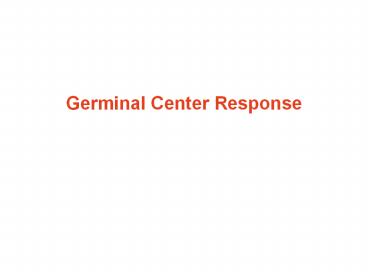Germinal Center Response PowerPoint PPT Presentation
1 / 48
Title: Germinal Center Response
1
Germinal Center Response
2
Hypermutation and selection
- Affinity of Serum Ig increases during an immune
response - Somatic mutation in Ig V region genes, in
response to protein, in B cells in mouse spleen
does not start until after the onset of Ab
production - 2. Mutational process occurs in centroblasts--gt
centrocytes are selected on basis of their
capacity for activation by antigen held on FDCs
3
The Germinal Center Reaction
B cells being tested for antibody affinity
Light zone
Antigen-retaining FDCs
Macrophage capturing dead B cells
Dark zone
Rapidly dividing and mutating B cells deep in the
center
4
Memory cell
plasmablast
CD40L
Apical light zone
plasmablast
Interaction w/Ag.
?
Basal light zone
Outer zone
No interact. W/Ag.
Death by apoptosis
?
Dark zone
5
(No Transcript)
6
(No Transcript)
7
(No Transcript)
8
Migration of plasma cells
9
Immunological Memory
- Four distinct phases
- 1. Induction of B cell memory
- GC reaction
- 2. Maintenance of a B cell memory compartment
- Non-secreting precursor to the memory response
- 3. Expression of B cell memory on re-challenge
- 4. Replenishment of the memory compartment
10
Summary of B-cell Development in Periphery
11
Major Events of Development and Maturation for T-
and B-cells Are Similar
12
T-cell Development Occurs In the Thymus While
B-cell Development Is in Bone Marrow
13
Thymic Stroma Provides A Unique Microenvironment
for T-cell Development
Thymic Stroma A network of epithelia
cells Analogous to the bone marrow stromal
cells that are required for B-cell development.
14
Experimental Data Demonstrating the Critical Role
of the Thymic Stroma in T-cell Development
Scid (severe combined Immunodeficiency) mice
defect in antigen-receptor gene
rearrangement Nude (hairless) mice defect in
whn transcription factor required for
the differentiation of epithelial cells
including thymic epithelial cells
15
Major Stages of T-cell Development
CD4-8-
16
Figure 7-13
Cell Surface Markers of T-cell Development
17
Process Gene Rearrangement Cell
Rearrangement of TCR Genes Is an important
indicator of T cell development
18
(No Transcript)
19
Selections and T-cell Maturation
20
Co-receptor Specificity of T-cell Is Determined
by the Types of MHC that the TCR interacts with
21
Positive Selection Is Mediated by Thymic Cortical
Epithelial Cells
22
While the Positive Selection Is Mediated by
Thymic Cortical Epithelia Cells, the Negative
Selection Is Largely Mediated by Bone
Marrow-derived APCs
Via positive and negative selections, mature T
cells acquire the ability to generate effector
mechanisms that serve to eliminate foreign but
not self antigens. Thus, peptides bound to MHC
determine final T-cell receptor repertoire.
23
(No Transcript)
24
Bim Plays an Important Role in Negative Selection
of Lymphocytes
25
Signaling via TCR Is Required for T-cell
Maturation and Survival
26
The Traffic of Lymphocytes Is Controlled by
Chemokines
27
Summary of T-cell Development in Thymus
28
Summary of T-cell Development in Periphery
29
Outline of T-cell Development and Maturation
Abbas
30
The ?/? Lineage is Distinct from the ?/? Lineage
31
(No Transcript)
32
(No Transcript)
33
Experiment showing education of T cells by Thymic
Epithelium
34
(No Transcript)
35
(No Transcript)
36
Humoral Immune Response
37
(No Transcript)
38
Figure 9-1 part 2 of 2
39
Two types of antigen, thymus-dependent (T-dependen
t) and thymus-independent (T- independent)
40
Thymus dependent antigenAntibody response
requires 2nd signal from T cellMHC class
II/peptide-TCR activates T cells --gt expression
of CD40L on T cell. CD40L interaction with CD40
on the B cell is the second signal
41
The same CD4 T cells (Thelper TH) that recognize
peptide-MHC class II, stimulate the B cells
that recognize the same Ag through The BCR
42
Thymus independent antigenCan get second signal
from TOLL receptor or cytokine signaling.
Usually the antigen is polymeric
43
(No Transcript)
44
(No Transcript)
45
Activation of TH cell by MHC class II peptide
induces Expression of CD40L and cytokines, that
activate B cells
46
Meeting of antigen-binding B and T cells at the
border Between the T-cell and B cell zones in the
spleen
47
Production of a germinal center
48
Lymphocytes circulate continually from the blood
into the peripheral Lymphoid tissues, they enter
by squeezing between the specialized endothelial
cells that appear to be larger than those found
elsewhere in the body--gtHigh Endothelial venules
(HEV).

